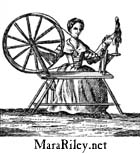| An Introduction to 18th Century Printed Textiles | |
|
Many reenactors have a difficult time determining which printed textiles are appropriate for their impressions. As a result, the usual advice is "avoid prints until you get a better feel for what's right", but how should we go about getting a feel for correct-looking prints? When shopping for fabric, it helps to have a basic knowledge of the technology used to print or paint 18th century fabrics. From the early 17th century through most of the 18th century, Indian printed textiles were hugely popular and imported in large numbers by the English and Dutch traders. These printed textiles were cotton, rather than linen or silk, although some linens were printed in Europe. Some patterned silks were imported from India, but these were largely warp-painted ikat fabrics, not printed. Some painted silks were imported from China. Various European governments passed laws to protect native textile industries, but printed fabrics, both domestic and smuggled imports, continued to be popular. By 1700, English calico printers learned to block print cotton and linen fabrics in a limited range of colors -- brown, black, red, and purple -- and merchants in the American colonies were importing English printed calico and chintz by the first quarter of the century (see Montgomery, Printed Textiles, pp. 16 - 25.) Some of these early printed textiles have survived as linings of stomachers, pocketbooks, trunks, and other items. By the middle of the 18th century, English textile printing was well-established and flourishing. It can be difficult to tell Indian from European printed textiles, because Europeans imitated Indian textiles and because Indian textiles made for export to Europe were printed specifically to meet European tastes. Terminology: Techniques: The process starts by sizing the fabric with a preparation of fatty milk and plant extracts containing tannic acid. The fabric is then dried thoroughly. The outline of the design is printed (the usual practice in Europe) or painted (in India) onto the fabric, using an ink that turns black (an iron oxide mixed with sugar or fruit juice) when it encounters the tannic acid on the fabric. The portions of the design that will be red are painted or printed with a mixture of alum and brazilwood. If printed, the mordant is made into a paste. The fabric is then dyed in a hot-water dye vat containing madder root or another red dye called chay (Oldenlandia umbellata). Next, the fabric is cleaned (traditionally with cow dung) to thoroughly remove the tanning agent. All sections of the fabric that should not be dyed blue are covered with wax resist (beeswax and resin). The fabric is then dyed in an indigo vat by dipping it three or four times to get a good blue color. The wax resist is removed by dipping it several times in hot water, then washed, dried, and sized. Last, thickened yellow dyes from various sources such as turmeric, pomegranite peel, or saffron, mixed with alum, are painted directly onto fabric, over blue portions if green is desired. Unfortunately, in many examples of 18th century chintz, the yellows have faded considerably, leaving the reds and blues, so branches and leaves that were once green are now blue, and yellow areas now appear tan. (For a detailed description of the above process, see Indigo Textiles, p. 108-109, and Woven Cargoes, p. 34-36) By about 1730, English dyers had developed a method of painting indigo directly onto fabric. The original recipe involves orpiment (arsenic trisulfide), which presents a hazard to the dyer, but Jim Liles, in The Art and Craft of Natural Dyeing, lists a recipe substituting less harmful chemicals (Liles, p. 93-94). Single-color copperplate printing was popular from around 1760 to 1800, making available prints with finer lines than were possible using wooden blocks. Many of the textiles produced using this method were large-patterned toiles, used predominantly for upholstery and drapery rather than clothing. Some single-color textiles with a smaller print were The process for roller printing fabrics was developed in 1783, with limited fabrics available at first, then becoming more widely used by 1810 to 1815. (Montgomery, Printed Textiles, p. 35). Copperplate printing and roller printing brought to market fabrics printed with much finer lines than were possible using wooden printing blocks. By and large, it is difficult to find appropriate block-printed fabrics for making 18th century clothing. Sometimes one can find an upholstery fabric that comes close, but often the pattern scale is too large for clothing. Indian bedspreads are one possible source for appropriate fabric, but be careful to avoid designs incorporating buta (i.e., paisley) motifs, which were not in common use before the end of the 18th century. Other print motifs to be avoided are overly naturalistic-looking flowers and "cabbage rose" type prints. Indian cottons made for the European market most frequently had a white ground, although the Dutch favored prints with a red ground. Fabrics with blue grounds are occasionally found, as well. In the late 1780s and 1790s, roller-printed fabrics with brown grounds became very popular. The best way to get a feel for these fabrics is to look through some of the books on period printed textiles recommended below. Styles: A note in John Fanning Watson's Annals of Philadelphia (1830),
accompanying two swatches of chintz used for 18th century gowns belonging
to his mother, notes that many gowns were lined with tammy stuff (i.e.,
wool in a plain weave), to keep them stiff, and were never washed
(Montgomery, Printed Textiles, p.45). |
|
|
Recommended Reading:
|
|
|
Links: Supplies: |
|
|
|
|
